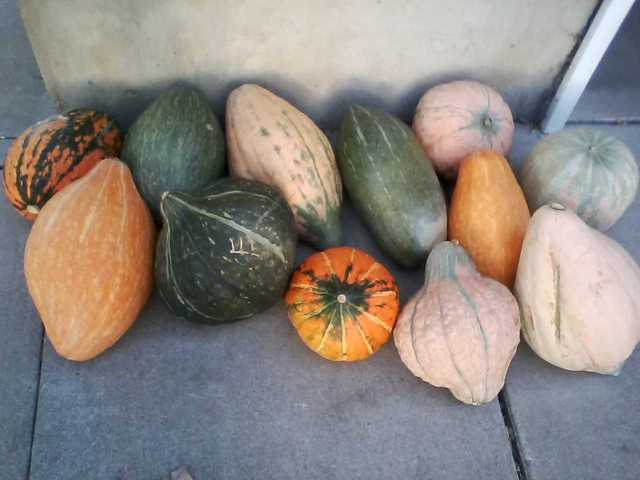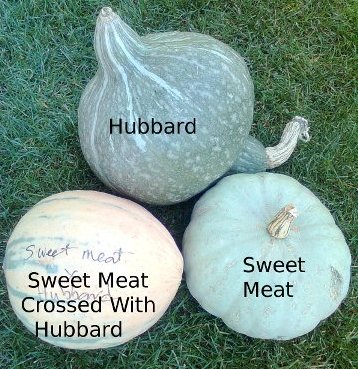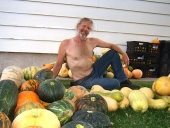posted 3 years ago
I already have more squash seeds than I can grow, but I'll try...I just bought 3 more mixed Maximas. Looking over the available squash, I could see traits with a fair number of them that indicated clear multi generation cross pollination. Some had Hubbard influence, Turban, cupping, various heirloom "pumpkin" squash influence, etc. I was half tempted to offer a price on the whole lot, but I don't think they are desperate enough yet with Thanksgiving on the horizon. They did finally mark them down in price a bit, so thought I'd pick a few out of the lot in case I missed them. Two of the three I chose were very similar in form. They were the reddish/green color of a Golden Hubbard, but large ovoid shape with shallow pumpkin type ribbing. The 3rd one looks like a blue Jarrahdale, but the blossom end terminated in a bulbous point like an acorn rather than concave like a typical pumpkin type. All 3 ranged from 16-18.25 pounds. See pics below.
I'm not sure yet what phenotype I want to eventually work toward, but some of the things that I think are important are longevity in storage, flavor/texture, dense fruit with small seed cavity compared to edible flesh. I like the hard skin for protection, and have so far avoided turban/cup types, because I read they don't keep as long due to the bottom seam. Though I'm sure there is a strong chance the pollen of those types got in there, I can select away from it. I tried to find ones that felt heavy for their size with the thinking that they were more densely filled.
Is there a shape or size that is easier to store or lasts longer in storage?
Is bumpy or peanut type skin more prone to harbor shelf-life shortening bacteria or fungus than smooth skin?
Are smaller squash genetically likely to produce smaller squash, or could they be the end of season "runts" of the larger varieties?
What are some preferred reasons to choose a small, medium, or large squash line to breed? Meaning, why would someone want to breed for a mid-size squash rather than a larger one? I imagine like anything, it's subjective to the cook's preferences, storage space, strength, etc. But is there something more to it? Like does the texture of larger squash suffer where small-medium size is better?
20221103_172557.jpg
![Filename: 20221103_172557.jpg
Description: [Thumbnail for 20221103_172557.jpg]](/t/197840/a/193925/thumb-20221103_172557.jpg)
20221103_180951.jpg
![Filename: 20221103_180951.jpg
Description: [Thumbnail for 20221103_180951.jpg]](/t/197840/a/193930/thumb-20221103_180951.jpg)
20221103_180927.jpg
![Filename: 20221103_180927.jpg
Description: [Thumbnail for 20221103_180927.jpg]](/t/197840/a/193931/thumb-20221103_180927.jpg)
Dirty hands + a sweaty handkerchief = hope for the future.

 2
2





 6
6







 6
6






















 1
1








 1
1























